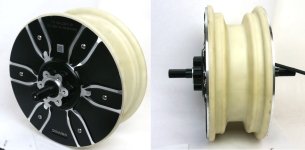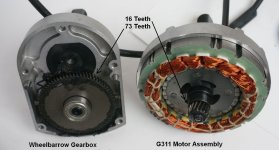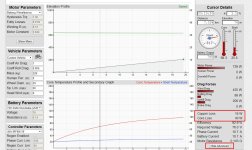Another oddball motor from Bafang isn't even on their webpage but is something that fits an interest of ours is this geared motor designed for a wheelbarrow.

There are many times when we have customers trying to find a hub motor for really high torque and low speed applications like this, and while some of the larger ebike motors can do 50-80Nm torque levels for a long enough time it's at quite a low efficiency if we're only moving at 5-10kph speeds.
I wasn't sure at all what to expect from the sample but the side cover had the text G311 lasered on it which I found interesting, and on opening it up sure enough the inside contained the same inrunner motor as a G311 ebike hub.

The difference is in the gearing through. This one has a 16T helical gear on the motor shaft driving a 73 tooth gear on a jackshaft, while the other side of the jackshaft had a 9 tooth spur gear turning inside a 59 tooth ring gear on the side plate of the hub housing

The total gear reduction is then 73/16 * 59/9 = 29.9 : 1, compared to 11:1 for the G311 ebike hub motor. So about a 3 times higher total gearing over the familiar ebike model. It also doesn't have any freewheeling clutch, so could be used bidirectionally and with regen too which is often needed in these applications (like say a winch for pulling rope).
I've got it live on the simulator if anyone wants to play with it, shown here hauling a 220lb load up a 10% grade slope effortlessly:
https://www.ebikes.ca/tools/simulator.html?motor=MG311_WB&cont=C20&wheel=16i&hp=0&grade=10
I didn't do a thermal study yet on this motor yet, but I put it in the database using same thermal characteristics as the G311 hub motor which shouldn't be too far off.

There are many times when we have customers trying to find a hub motor for really high torque and low speed applications like this, and while some of the larger ebike motors can do 50-80Nm torque levels for a long enough time it's at quite a low efficiency if we're only moving at 5-10kph speeds.
I wasn't sure at all what to expect from the sample but the side cover had the text G311 lasered on it which I found interesting, and on opening it up sure enough the inside contained the same inrunner motor as a G311 ebike hub.

The difference is in the gearing through. This one has a 16T helical gear on the motor shaft driving a 73 tooth gear on a jackshaft, while the other side of the jackshaft had a 9 tooth spur gear turning inside a 59 tooth ring gear on the side plate of the hub housing

The total gear reduction is then 73/16 * 59/9 = 29.9 : 1, compared to 11:1 for the G311 ebike hub motor. So about a 3 times higher total gearing over the familiar ebike model. It also doesn't have any freewheeling clutch, so could be used bidirectionally and with regen too which is often needed in these applications (like say a winch for pulling rope).
I've got it live on the simulator if anyone wants to play with it, shown here hauling a 220lb load up a 10% grade slope effortlessly:
https://www.ebikes.ca/tools/simulator.html?motor=MG311_WB&cont=C20&wheel=16i&hp=0&grade=10
I didn't do a thermal study yet on this motor yet, but I put it in the database using same thermal characteristics as the G311 hub motor which shouldn't be too far off.



